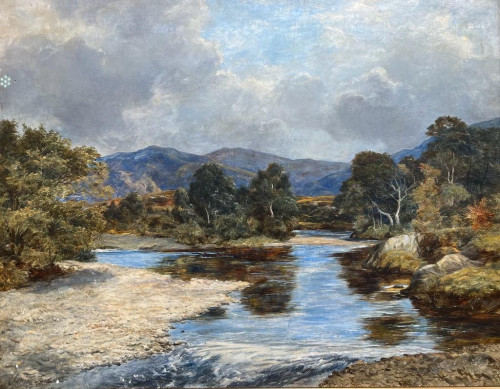James Faed Jnr

1856 - 1920
James Faed 'Junior,' the eldest son of James Faed and Mary Cotton, was born at Overshiel House in Mid-Calder, Midlothian on 21 September 1856. Called 'Jamie' in his youth, his early life must have mostly been spent in Edinburgh, possibly travelling to London, where his father was at the time gaining a reputation as a mezzotint engraver.
His uncles had excelled in pictures of humble Scottish life and people, but James Faed Junior was essentially a landscape painter, inspired directly by his father. He really captured the depth and colour of the Scottish countryside and, in particular, his treatment of heather and running water is highly thought of. His later canvases in oil are reminiscent of Horatio MacCulloch's grand highland scenes, while his lowland watercolours follow the style of Sam Bough. Faed's landscapes would also have been influenced by artists like Peter Graham, a friend of Thomas Faed, and John MacWhirter, whom he later knew in London.
Like earlier artists, he spent time in the 1870s and 1880s painting and sketching in Cadzow Forest near Hamilton. He exhibited at the RSA from 1876 and won a Bronze Diploma Medal at the International Exhibition in 1886 for his Springtime in Cadzow Forest. Many works also appeared at the RGI and he also exhibited at the Royal Academy.
He spent time at Appin, Loch Fyne and in the Trossachs. In addition to works on the Avon and in Cadzow Forest, he sketched in the Edinburgh area, in Invernesshire and on the west coast of Sutherland.
James
James Faed 'Junior,' the eldest son of James Faed and Mary Cotton, was born at Overshiel House in Mid-Calder, Midlothian on 21 September 1856. Called 'Jamie' in his youth, his early life must have mostly been spent in Edinburgh, possibly travelling to London, where his father was at the time gaining a reputation as a mezzotint engraver.
His uncles had excelled in pictures of humble Scottish life and people, but James Faed Junior was essentially a landscape painter, inspired directly by his father. He really captured the depth and colour of the Scottish countryside and, in particular, his treatment of heather and running water is highly thought of. His later canvases in oil are reminiscent of Horatio MacCulloch's grand highland scenes, while his lowland watercolours follow the style of Sam Bough. Faed's landscapes would also have been influenced by artists like Peter Graham, a friend of Thomas Faed, and John MacWhirter, whom he later knew in London.
Like earlier artists, he spent time in the 1870s and 1880s painting and sketching in Cadzow Forest near Hamilton. He exhibited at the RSA from 1876 and won a Bronze Diploma Medal at the International Exhibition in 1886 for his Springtime in Cadzow Forest. Many works also appeared at the RGI and he also exhibited at the Royal Academy.
He spent time at Appin, Loch Fyne and in the Trossachs. In addition to works on the Avon and in Cadzow Forest, he sketched in the Edinburgh area, in Invernesshire and on the west coast of Sutherland.
James
Faed Junior married late in life (1897) to Eleanor Annie Herdman, who came from a flour milling family of East Lothian and Edinburgh. The Faeds moved to London quite soon afterwards and their first son - James Ronald Herdman (Ronnie) - was born there in May 1899. Their home was in the artists' colony of St John's Wood, at 38 Abbey Road , till just before the First World War. James Junior seems to have been close to his uncle Thomas Faed, who also lived in St John's Wood till his death in August 1900.
Based in London, the Faeds spent at least one part of the next nine years in Scotland. In 1902, they took a house in Cannes in the south of France and were there again in 1904-05. The Kirkcudbright artist Jessie M King, among others, visited the Faeds during the second trip.
Their second child, John Alastair Faed, was born in November 1905.
As well as the author JM Barrie and sculptor John Adams Acton, Sir Harry Lauder visited the Faeds in Abbey Road. He later composed the well-known song Keep Right on to the End of the Road, which he said had been inspired by a painting in Faed's studio.
They had a house in New Galloway from 1912, and by 1913 were resident permanently in Scotland. Their eldest son Ronnie entered the Royal Navy as a midshipman at the outbreak of war. He was lost, when his ship Goliath was torpedoed in the Dardanelles in May 1915.
James Faed Junior did little painting after 1915, and what he did was done with his mouth as his hands had become paralysed. He died on 17 February 1920 in his 64th year and was buried in Kells Churchyard above New Galloway. James Faed's widow lived there a little longer but soon returned to Edinburgh. Their surviving son emigrated to Africa in 1927 and his mother later spent some time there with him before her death in 1951.
0 ITEM
